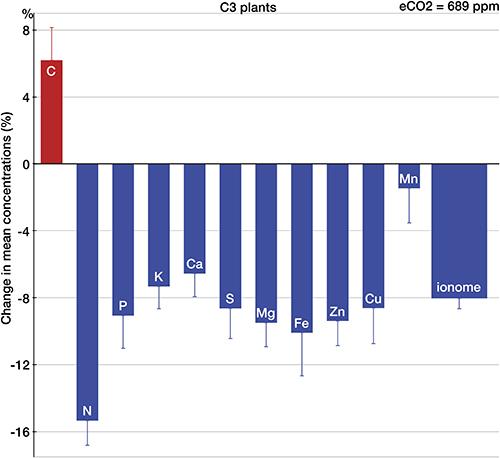Politico offered the following headline, The great nutrient collapse, The atmosphere is literally changing the food we eat, for the worse. The article that followed reviewed a meta-analysis that was thought-provoking but did not go as far as Politico’s enticing header.
The analysis, written by Irakli Loladze, looked at the impact of rising atmospheric levels of carbon dioxide, CO2, on plants. CO2 is a plant nutrient, and increased levels result in greater plant growth. Since the industrial revolution atmospheric CO2 has risen from about 280 parts per million (ppm) to 400 parts per million (the underlying cause is irrelevant to plants). In some ways, this is good, as Representative Lamar Smith, chair of the House Science Committee states, “A higher concentration of carbon dioxide in our atmosphere would aid photosynthesis, which in turn contributes to increased plant growth. This correlates to a greater volume of food production and better quality food.” Loladze’s meta-analysis questions the “better quality” part of Representative Smith’s statement.
Here is what the study found:
- In temperate, cool-season plants like rice and wheat (known as C3 plants) elevated concentrations of atmospheric CO2 resulted in plants with less protein, more carbohydrates and reduced amounts of 25 important minerals (collectively referred to as the ionome)
- In tropical or warm season plants like corn or millet (known as C4 plants) elevated concentrations of atmospheric CO2 resulted in similar changes although not as marked and there were no statistically significant changes in their mineral content.
One of the unusual qualities of the paper was that it was written by a mathematician with a solid grounding in agriculture. Evidently, as the author writes,
“plant quality, including the plant ionome…is inherently variable; and measurement imprecisions further amplify the variability. ..Therefore, CO2-induced changes in the plant ionome (the signal) can be easily lost amid highly variable data (the noise)”
By increasing sample size the statistical signal was heard. Increasing meaningful sample size is difficult in this case because plants grown indoors may not respond as plants do in their natural environment. And studies of plants in nature use a technique called free-air CO2 enrichment (FACE) where levels are artificially raised continuously in a field, an expensive undertaking. That said, Loladze found increased carbohydrates, lower protein and mineral levels for plants in indoor and FACE studies when exposed to increased atmospheric CO2.
So while the bottom line in the meta-analysis is that rising atmospheric CO2 alters the composition of plants, the Politico article leaves out some of the subtlety of the findings.
- The changes in the range of about an 8% decrease in mineral composition were found in CO2 concentrations of 689 ppm. Lower CO2 ppm were associated with more moderate reductions, extrapolating to our current levels, the mineral decrease was perhaps 4%.
- The mineral decreases were greater in the leafy components of the plants, not the edible portions so again the actual mineral decrease in the plants entering our food chain is lower, say a 2% decrease
The Politico article seeks to add just a bit more concern and anxiety providing the following context:
"Earlier this summer, a group of researchers published the first studies attempting to estimate what these shifts could mean for the global population. …by 2050, …150 million people could be put at risk of protein deficiency… a loss of zinc, which is particularly essential for maternal and infant health, could put 138 million people at risk, … more than 1 billion mothers and 354 million children live in countries where dietary iron is projected to drop significantly, which could exacerbate the already widespread public health problem of anemia. There aren’t any projections for the United States, … but some researchers look at the growing proportion of sugars in plants and hypothesize that a systemic shift in plants could further contribute to our already alarming rates of obesity and cardiovascular disease.”
Perhaps this is a bit of journalistic enhancement. Returning to Loladze’s paper, he states that how the noted changes “affect human nutrition is still unknown.” His discussion is remarkable on two points. First, he mentions “hidden hunger,” when a plant-based diet provides sufficient calories but not complete nutrition. This hidden hunger is, in fact, a primary source of malnutrition. Second, he notes
“…that the minuscule amount of minerals, which a human body requires, could be provided easily and inexpensively—at least in theory—to all people in need by fortifying foods with minerals. However, in practice, such required mineral levels do not reach large parts of the world's community.”
Loladze goes on to argue that the increasing carbohydrate component of plants could be responsible for the increased weight gain in the population. The article makes clear that this is conjecture, a thought experiment. Politico misses that subtlety. The paper includes the concerns of the peer reviewers, who initially rejected the paper. They wrote
“After discussion, a consensus agreement was reached that the manuscript could be accepted if it was substantially revised so that it was clear that impact of changes in nutrient content of the edible portion of food crops on human health has not been settled.”
I applaud the publication of the reviewer’s remarks, it provides expert context and reveals some of the hidden changes that are part of science publishing.




